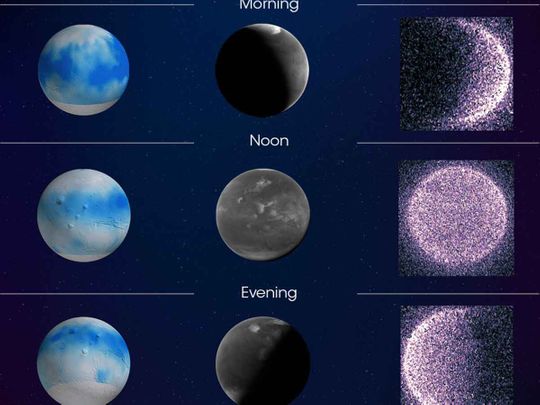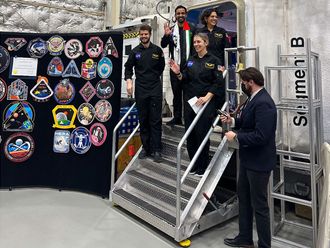
Dubai: Emirates Mars Mission (EMM), the first interplanetary exploration undertaken by an Arab nation, today released new images of Mars taken by Hope Probe.
Hope Probe is building a new global picture of Mars’ atmospheric dynamics with observations taken by its three instruments — EMIRS (Emirates Mars InfraRed Spectrometer), EXI (Emirates eXploration Imager) and EMUS (Emirates Mars InfraRed Spectrometer) — to fully characterise the diurnal (daytime) and seasonal behaviour of Mars’ atmosphere for the first time ever.
New observations
According to EMM, UAE’s mission to Mars “has triggered a rush of new observations, discoveries and insights into Mars’ unique atmosphere, its composition and dynamics”.
“The success of Hope Probe is already assured from our early results and observations and we can already see a vast number of new potential avenues of exploration opening up as a result of our early data,” said EMM Science Lead, Hessa Al Matroushi. “We are seeing Mars in remarkable detail and are able to characterise the diurnal behaviours of Mars’ atmosphere for the first time ever. The potential we are now seeing from the mission undoubtedly exceeds our expectations,” Al Matroushi noted.
EMM earlier shared new observations of Mars’ discrete aurora and unprecedented views of dayside oxygen and carbon monoxide structures in the planet’s atmosphere.
EMM noted that papers and posters being shared and presented at the AGU21 (American Geophysical Union ) Fall Meeting in New Orleans reflect the unique picture of Mars’ atmosphere being built by EMM’s Hope Probe. Its advanced instrumentation and smart elliptical orbit provide new views of the Martian atmosphere at all times through the day, night and seasons of the Red Planet.
Mars atmosphere
Christopher S. Edwards, EMIRS Instrument Lead, said: “The ability of EMM to observe Mars at all local times on short timescales enables the daily variation of these clouds to be studied. The EMIRS observations show that clouds are thickest and cover the most area early in the morning and late in evening with fewer clouds near midday. The comparison of clouds observed by EMIRS at thermal-infrared wavelengths to those observed by EXI at visible wavelengths can provide further information about the clouds, such as size of the water ice aerosols that make up the clouds.”
“As on the earth, clouds on Mars are an important part of the water cycle and characterizing how they change from hour-to-hour and day-to-day is an important part in understanding both the present and past climates,” added Michael Wolff, EXI Instrument Lead.
Science data for all
EMM noted: “Hope Probe’s ground-breaking observations are available to scientists and enthusiasts globally, uploaded to the EMM Science Data Centre and available freely from the emm.ae website.”
“With early results showing exciting observations of Mars’ discrete aurora and additional bandwidth and resources available to encompass additional observations, further measurements of auroral phenomena have been brought into the mission’s goals, extending its capabilities beyond Hope Probe’s planned goals,” EMM added.
An aurora is a natural phenomenon, which is characterised by a display of a natural-coloured (green, red, yellow or white) light show, which is caused when electrically-charged particles from the sun collide with particles from gases such as oxygen and nitrogen present in the atmosphere.
Revolutionary implications
According to EMM, the images taken by Hope Probe “have revolutionary implications for our understanding of the interactions between solar radiation, Mars’ magnetic fields and the planetary atmosphere”.
“By comparing the images of hydrogen that we gain from the EMUS instrument to the maps of water ice, water vapour and dust acquired by the EXI and EMIRS instruments, scientists will be able to reconstruct the details of how hydrogen is transported through the Martian atmosphere and how water has been lost from the planet over the history of the Solar System,” explained EMM deputy science lead and EMUS instrument lead Justin Deighan.
Read more
- Watch: First call between UAE's primary analog astronaut Saleh AlAmeri and backup astronaut Abdalla AlHammadi
- Emirates Astronomical Observatory discovers three new variable stars
- UAE night sky to see spectacular peak of Geminid meteor shower on Monday
- Energy-saving drive begins at Seha health-care facilities in Abu Dhabi
He added: “Thanks to the uniquely large orbit of the Hope Probe around Mars, the instruments on the Hope Probe are able to view the planet from different points of view across all times of the day, bringing powerful new insights to our understanding of Mars’ atmospheric dynamics.”










